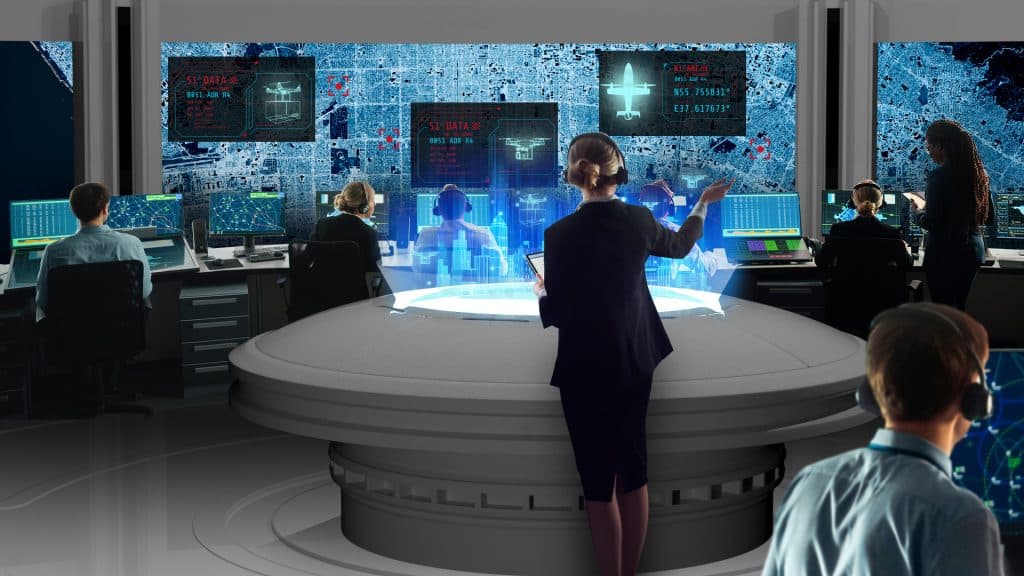Raytheon Intelligence’s End-to-end Capabilities Support the AAM Market
June 14, 2022 | AUVSI News

As technological capabilities and updated regulatory frameworks progress, the advanced air mobility (AAM) space is rapidly growing – and AUVSI’s member organizations are laying the foundation for this industry’s future. AUVSI connected with Dr. Waseem Naqvi, Director of Technology, Unmanned Systems, Communications and Airspace Management Systems at Raytheon Intelligence & Space (RI&S) to hear his insights on the future of the AAM industry, changes that must be made to accommodate an increasingly crowded airspace, and how RI&S is supporting this market. Naqvi has served on AUVSI’s Board of Directors since 2016.
The Future of AAM and Next-Gen NAS Needs

“With many companies investing in this new industry, AAM is coming – we are entering a new era of airspace,” Naqvi explains. “Traditionally it has been about aircraft carrying goods and people from one city to another. Now we have a new world where small UAS and larger AAM systems are operating in the airspace in and around cities – it’s a new generation of air transportation that is intra-city and intra-region.” But he adds: “The bigger picture is that the AAM industry will need access to the airspace. For the industry to be successful, there must be enabling infrastructure and systems to support the smaller airspace volumes, and larger number of aircraft operations within those volumes.” While the AAM market is still young, there are new problems that must be solved to enable the integration of these aircraft into cities and regions, at-scale. Naqvi encourages the industry to think beyond immediate aircraft certification and electric propulsion issues. Investments are needed in vertiports, obstruction avoidance, urban navigation, and more. “Raytheon Intelligence & Space is actively investing and researching now to prepare for the future of this market,” Naqvi says. Naqvi shares examples of how Raytheon Intelligence & Space is anticipating the AAM industry’s needs:
-
Currently, terminal area management, a very tactical airspace, is capped to a limited number of aircraft. Given that market predictions for AAM aircraft in the coming decades will be in the tens of thousands over cities, a new type of scalable airspace management structure will be required.
-
Additionally, vertiports will need to be closer to where people live than airports for AAM technologies to achieve their goal of rapid, intermodal transportation. At each vertiport, obstruction avoidance, microweather awareness, and urban landscape navigation will need to be secure even in situations with signal interference.
-
Finally, airspace authorities will need to consider a more holistic picture of the National Airspace System (NAS), including how they will manage new types of aircraft that will soon come to market. As our system transitions from the former analog aircraft management approach to a new era of machine-to-machine communications, there will be a time when both analog and digital are in use. While airspace authorities may not yet be prepared to integrate these approaches, RI&S is leading the way in pursuing innovative solutions to these issues.
Raytheon Intelligence & Space’s Solutions

To accommodate the new volume and type of automated aircraft that will eventually dominate the national airspace (NAS), the scalability of communications, navigation, and surveillance, and other air traffic management systems will be key. RI&S is one of the largest suppliers worldwide of end-to-end capabilities in radar and surveillance, communications and navigation, command and control, cybersecurity, and space augmentation technologies. They are modernizing the airspace and supporting the AAM market of the future by:
-
Developing next generation integrated airspace infrastructure — called the Integrated Transportation Advanced Airspace Mobility Services (ITAAMS) — an automation framework to support integrated airspace from the surface to near space, both for the U.S. and globally.
-
Developing precision landing capabilities that allow aircraft to land with pinpoint accuracy and make terminal areas without ground-based navigation available to pilots. Learn more about RI&S’s Joint Precision Approach and Landing System (JPALS) and Wide Area Augmentation System (WAAS), which enables pilots to fly using augmented GPS data.
-
Providing air traffic control (ATC) systems to enable safe and efficient aircraft spacing and sequencing in urban terminal areas. Learn more about RI&S’s Standard Terminal Automation Modernization and Replacement System (STARS), which handles approximately 80 percent of the air traffic in the U.S.
-
Identifying micro weather to make small aircraft, low-altitude flight possible. Learn more about RI&S’s Skyler radar, which tracks aircraft and weather events that typically go undetected in low altitude.
-
Upgrading legacy air traffic systems incrementally and preserving the capital investment can be a challenge. RI&S’s Multi-platform Application Re-hosting Solution, known as MARS, enables incremental upgrades showing multiple data streams of various vantages on a single workstation.
-
Providing information, systems and operations security that will be even more critical as new types of highly-automated aircraft come online. Learn more about RI&S’s full suite of cybersecurity solutions for government agencies and businesses.
In summary, Raytheon Intelligence & Space provides end-to-end CNS/ATM solutions, in civil and defense markets, and are actively investing in this new era of flight. Visit Raytheon Intelligence and Space’s website to learn more about their Multi-platform Application Re-hosting Solution, Wide Area Augmentation System, and work with universities on the future of the national airspace.
- Industry News


